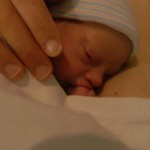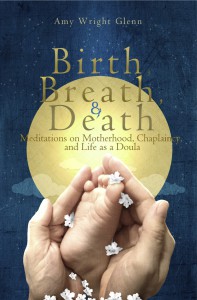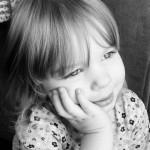By Walker Powell
 I became pregnant quite by accident when I was a senior in college. I’d never really considered different birth options before, but I knew immediately that I wanted a natural home birth.
I became pregnant quite by accident when I was a senior in college. I’d never really considered different birth options before, but I knew immediately that I wanted a natural home birth.
I sailed through most of my pregnancy without a single complaint, received glowing reports at my prenatal exams, and avoided the hospital entirely except for a single ultrasound to determine the due date. My boyfriend was amazingly supportive, I think he might have been even more excited than me. I was a little nervous, but I was also looking forward to meeting this creature who had taken my by surprise. I was convinced I would do so at home after a relaxing, peaceful labor.
I read all the traditional natural birth books, but my favorite was Ina May Gaskin’s classic Spiritual Midwifery. At that point, I had never heard of Attachment Parenting, though unconsciously I was already planning an AP birth. Of course, things never work out the way we plan.
At my 38-week appointment, one of my midwives, J., looked worried. I had slightly elevated blood pressure, and the baby seemed to have stopped growing. I didn’t have any other signs of preeclampsia, and the baby was still kicking like crazy, so J. said she wasn’t too concerned. However, she suggested that I see the midwife at the hospital and get an ultrasound. I did, suddenly fearful, but the other midwife wasn’t concerned at all, and the ultrasound only revealed a perfectly healthy baby.
I returned home, worried now that my dreams of a natural birth were falling to pieces. We spent the next few days doing anything we could to get this baby out. Exercise, raspberry tea, herbal supplements, sex, whatever we could think of. Four days before our due date, I hiked to the top of a mountain. There were no contractions, but my boyfriend did propose on the summit under some trees. I said yes.
The following week I was told to go in for a non-stress test because the hospital midwife had realized that she had the wrong due date and was suddenly very worried about the baby’s size. I did, and we passed with flying colors, but no one was satisfied. The midwife suggested an induction but said she’d let us decide. We opted to wait.
That very afternoon she called again to say that the doctors had reviewed my case again and strongly recommended an immediate induction. They could have me in that night, she said. I was caught off guard, unsure what to do. I called my home birth midwives, and we decided together that I should go for the induction.
That night, my fiance and I checked into the hospital birthing center to have our baby. They gave me Cervidil, hooked a heart rate monitor to my belly, and left me to try to sleep in the narrow hospital bed. A nurse came in every hour to adjust the monitor, but I managed to sleep a little.
The following day started slowly. One of my midwives, M., came in the mid-morning and kept us company. We watched TV and relaxed all morning. The birthing center was a welcoming place where we had our own room and were rarely bothered by nurses or doctors. The contractions were starting but they were mild, barely worse than the Braxton-Hicks contractions I’d been experiencing off and on during the last few weeks.
By lunchtime I was restless and didn’t feel like eating. We took a walk instead, out to a scrap of grass behind the parking lot. M. did some moxibustion to speed up the labor because she was worried the nurses would give me Pitocin if they didn’t see some progress. It worked, and within an hour I could no longer talk through the contractions.
I took a long, hot shower with my fiance, swaying with him at each contraction. Things were going well, I thought, though it scared me a little that it hurt so much when I’d barely begun.
Then things got confusing. The nurses made me come back to bed so they could hook up the monitor, take my blood pressure, draw blood, and get a urine sample. There was a lot of hushed muttering. M. looked worried. I was focusing on the contractions and didn’t pay much attention. They drew my blood a few more times, leaving my arms dotted with bruises.
Next they were putting an IV in my arm and telling me I had preeclampsia and that I needed this drug to protect me from seizures. The drug made me feel heavy, so heavy I couldn’t even open my eyes. It also slowed the contractions down so much the nurses had to give me Pitocin as well. The Pitocin made me feel like I was burning up, and my fiance had to wash my face and neck with a cold cloth.
Several hours passed, I think. I couldn’t tell time, nor did I know exactly what was happening.The contractions came hard and fast due to the Pitocin; I never got a break. The nurses asked if I wanted a painkiller, and I said yes–not an epidural, but something that would dull the pain a little. The painkiller let me doze between contractions for a bit. Finally the staff checked my cervix and found that I had only dilated 1 cm. I did feel a little nervous then, but M. took charge. To this day I’m convinced we would have ended up with a cesarean section if she hadn’t been there.
The baby was positioned faceup, which we’d known for a few weeks, so M. suggested I get on all fours while she jiggled my stomach with a long piece of cloth called a rebozo. The nurses weren’t too happy about the monitor getting disrupted, but it only took about 10 minutes, then I was on my back again. Almost instantly, my water broke and the contractions grew much more intense. What seemed like a very short time later, I began to feel the urge to push. The nurse checked me again and with a big grin announced that she could see the head. “Let’s have a baby,” she said.
I was having that baby whether she said so or not.
In a strange moment of clarity, I remembered reading that the pushing stage can last an hour or more. I knew with utter certainty that I was not doing this for an hour. I know that some women prefer pushing because it feels like they are finally doing something, and it was nice to know the end was near, but it hurt far too much for me to want it to last. I think it was about half an hour of pushing, in the end.
They tried to get me to feel the head when it crowned, but I didn’t care. I pushed harder, felt a sharp pain, then the baby slid out in one smooth motion. There was a sudden flurry of action as my fiance cut the cord and the staff swept the squirmy purple body away. As I expelled the afterbirth, I heard the announcement that it was a boy. I remember thinking they must have the wrong baby; I was going to have a girl. I had known that since I’d found out I was pregnant. Then they placed him on my stomach, tiny and wet and perfect, and he crawled right up to my breast and started to nurse.
Jack Christian was born at 11:47 p.m., a little peanut at 5 pounds, 7 ounces and 19 inches long, but perfectly healthy and alert, with his father’s monkey ears and my button nose. We chose to keep him uncircumcised, but at the time I didn’t know enough to have opinions about other routine hospital procedures. I only knew I wanted him with me 24/7, which I believe is the main reason we never once struggled with breastfeeding. The nurses were very supportive of that, which made it easier. Even with his low birth weight and some jaundice, they never once suggested supplementing with formula.
I don’t have any regrets about not getting the natural home birth I wanted, though I would like to try again in a few years with the next baby. I am just glad that Jack was born healthy and safe.
For two weeks following his birth, I was surrounded by my mom and three sisters. Even though my fiance had to go back to work more than 60 hours a week just three days after Jack’s birth, I was able to relax during those first two weeks.
The rest of his first year was incredibly difficult, and I suffered from postpartum depression for several months, mostly due to my fiance being gone so often and Jack sleeping very poorly. I had almost no support besides online groups, and I think I also had a great deal of trouble adjusting to this enormous and unplanned change in my life. Luckily I discovered AP and can at least know that even when I was at my most depressed, I still gave Jack the best care I could. He is an incredibly happy, healthy, smart and loving baby, the center of my world.
To share your birth story with API readers, see our submission guidelines for more information.







